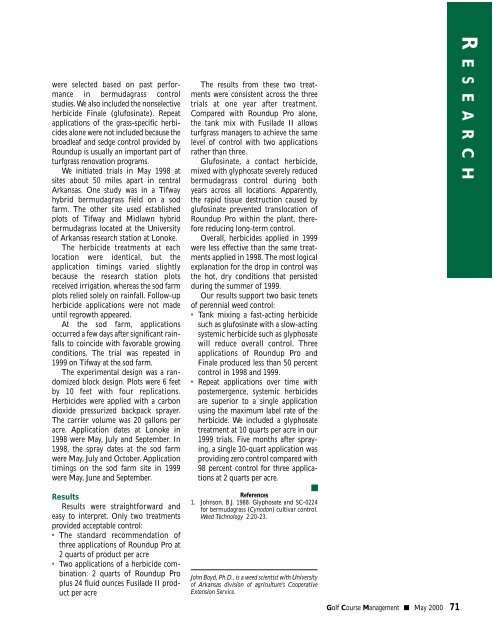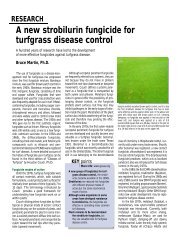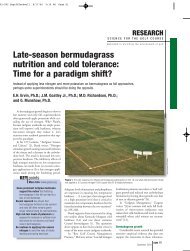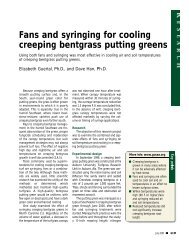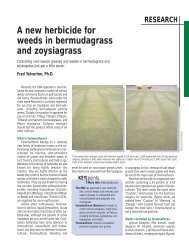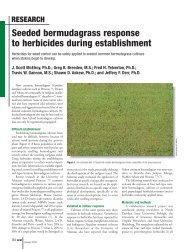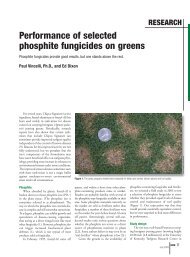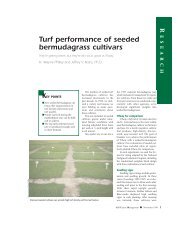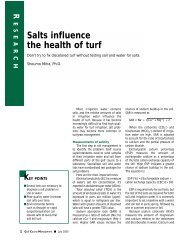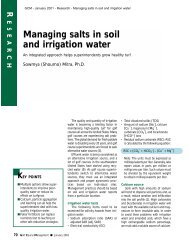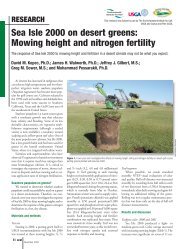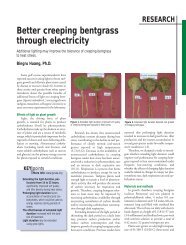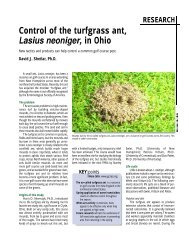Kill off bermudagrass with one less spraying - GCSAA
Kill off bermudagrass with one less spraying - GCSAA
Kill off bermudagrass with one less spraying - GCSAA
Create successful ePaper yourself
Turn your PDF publications into a flip-book with our unique Google optimized e-Paper software.
were selected based on past performancein <strong>bermudagrass</strong> controlstudies. We also included the nonselectiveherbicide Finale (glufosinate). Repeatapplications of the grass-specific herbicidesal<strong>one</strong> were not included because thebroadleaf and sedge control provided byRoundup is usually an important part ofturfgrass renovation programs.We initiated trials in May 1998 atsites about 50 miles apart in centralArkansas. One study was in a Tifwayhybrid <strong>bermudagrass</strong> field on a sodfarm. The other site used establishedplots of Tifway and Midlawn hybrid<strong>bermudagrass</strong> located at the Universityof Arkansas research station at Lonoke.The herbicide treatments at eachlocation were identical, but theapplication timings varied slightlybecause the research station plotsreceived irrigation, whereas the sod farmplots relied solely on rainfall. Follow-upherbicide applications were not madeuntil regrowth appeared.At the sod farm, applicationsoccurred a few days after significant rainfallsto coincide <strong>with</strong> favorable growingconditions. The trial was repeated in1999 on Tifway at the sod farm.The experimental design was a randomizedblock design. Plots were 6 feetby 10 feet <strong>with</strong> four replications.Herbicides were applied <strong>with</strong> a carbondioxide pressurized backpack sprayer.The carrier volume was 20 gallons peracre. Application dates at Lonoke in1998 were May, July and September. In1998, the spray dates at the sod farmwere May, July and October. Applicationtimings on the sod farm site in 1999were May, June and September.ResultsResults were straightforward andeasy to interpret. Only two treatmentsprovided acceptable control:• The standard recommendation ofthree applications of Roundup Pro at2 quarts of product per acre• Two applications of a herbicide combination:2 quarts of Roundup Proplus 24 fluid ounces Fusilade II productper acreThe results from these two treatmentswere consistent across the threetrials at <strong>one</strong> year after treatment.Compared <strong>with</strong> Roundup Pro al<strong>one</strong>,the tank mix <strong>with</strong> Fusilade II allowsturfgrass managers to achieve the samelevel of control <strong>with</strong> two applicationsrather than three.Glufosinate, a contact herbicide,mixed <strong>with</strong> glyphosate severely reduced<strong>bermudagrass</strong> control during bothyears across all locations. Apparently,the rapid tissue destruction caused byglufosinate prevented translocation ofRoundup Pro <strong>with</strong>in the plant, thereforereducing long-term control.Overall, herbicides applied in 1999were <strong>less</strong> effective than the same treatmentsapplied in 1998. The most logicalexplanation for the drop in control wasthe hot, dry conditions that persistedduring the summer of 1999.Our results support two basic tenetsof perennial weed control:• Tank mixing a fast-acting herbicidesuch as glufosinate <strong>with</strong> a slow-actingsystemic herbicide such as glyphosatewill reduce overall control. Threeapplications of Roundup Pro andFinale produced <strong>less</strong> than 50 percentcontrol in 1998 and 1999.• Repeat applications over time <strong>with</strong>postemergence, systemic herbicidesare superior to a single applicationusing the maximum label rate of theherbicide. We included a glyphosatetreatment at 10 quarts per acre in our1999 trials. Five months after <strong>spraying</strong>,a single 10-quart application wasproviding zero control compared <strong>with</strong>98 percent control for three applicationsat 2 quarts per acre.■References1. Johnson, B.J. 1988. Glyphosate and SC-0224for <strong>bermudagrass</strong> (Cynodon) cultivar control.Weed Technology 2:20-23.John Boyd, Ph.D., is a weed scientist <strong>with</strong> Universityof Arkansas division of agriculture’s CooperativeExtension Service.Golf Course Management ■ May 2000 71R E S E A R C H


